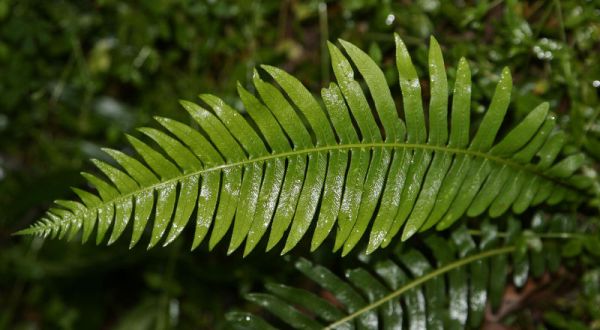
| Palaeos |  |
Chlorobionta |
| Plants | Chlorobionta |
| Page Back | Unit Back | Plants | Dendrogram | References | Taxon Index | Pieces |
| Page Next | Unit Next | Unit Home | Glossary | Time |
LIFE |--Eubacteria `--Eukarya |--+--Rhodophyta | `--CHLOROBIONTA | |--Chlorophyta | `--Charophyta | |--(various green algae) | `--Embryophyta | |--Bryophyta | `--Tracheophyta (rhyniophytes) | |--Lycophyta | `--Euphyllophyta | |--Monilophyta | `--Spermatophytata | |--Trimerophytes | `--Spermatopsida `--+--Fungi `--Metazoa |--Chordata `--Protostomia |
Lists Glossary Taxa References "The Wearing of the Green" Evolution of Land Plants Green Algae Plants Conquer the Land The Devonian Period The Carboniferous Period The Diversity of Plants Chlorobionta (Prasinophyta) Chlorophyta Charophyta Embryophyta Bryophyta Tracheophyta Lycophyta Euphyllophyta Monilophyta Spermatophytata Links |

Fern, Blechnum nudum from Nunniong, Australia (Tracheophyta, Euphyllophytina,Moniliformopses, Pteridophyta, Polypodiopsida, Hymenophyllidae, Aspidiales, Blechnaceae).( Wikipedia)
A. Glossary of terms and abbreviations.
A B C D E F G H I J K L M N O P Q R S T U V W X Y Z
B. Taxon Index: alphabetical list of taxa.
A B C D E F G H I J K L M N O P Q R S T U V W X Y Z
C. References: literature citations by author.
A B C D E F G H I J K L M N O P Q R S T U V W X Y Z
Aristotle divided all living things between plants, which generally do not move, and animals, which do. In Linnaeus' system, these became the Kingdoms Vegetabilia (later Plantae) and Animalia. Since then, it has become clear that the Plantae as originally defined included several unrelated groups, and the fungi and several groups of algae were removed to new kingdoms. However, these are still often considered plants in many contexts. Indeed, any attempt to match "plant" with a single taxon is doomed to fail, because plant is a vaguely defined concept unrelated to the presumed phylogenetic concepts on which modern taxonomy is based. At the very least, there are three distinct monophyletic definitions - the descendants of the primary endosymbiosis homologous with land plants, the green photosynthetic clade (also called Chlorobionta), or the land plants only (also called Embryophyta). (modified from Wikipedia)
| Page Back | Page Top | Unit Home | Page Next |
text by M.Alan Kazlev Creative Commons Attribution, except text signed ATW which is public domain
page uploaded 7 April 2002, last modified ATW090227, MAK120215